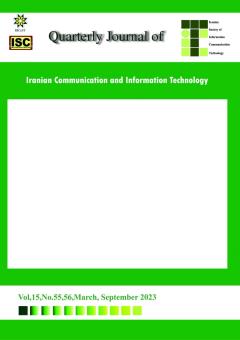فناوری های نوظهور در نسل های آتی رایانش فوق سریع: معرفی، دسته بندی و فرصت های تحقیقاتی پیش رو
الموضوعات : فناوری اطلاعات و ارتباطات
محمود نعمت اله زاده
1
,
احسان آریانیان
2
,
مسعود حایری خیاوی
3
![]() ,
نيلوفر قلي پور
4
,
عبدالله سپهوند
5
,
نيلوفر قلي پور
4
,
عبدالله سپهوند
5
1 - پژوهشگاه ارتباطات و فناوري اطلاعات
2 - .مرکز تحقیقات مخابرات ایران
3 - پژوهشگاه ارتباطات و فناوري اطلاعات
4 - پژوهشگاه ارتباطات و فناوري اطلاعات
5 - پژوهشگاه ارتباطات و فناوري اطلاعات
الکلمات المفتاحية: رایانش فوق سر یع, رایانش کوانتومي, رایانش مولکولي, رایانش زی ست ي, رایانش ع صبگون, رایانش نوري, رایانش نانو, رایانش حافظهاي.,
ملخص المقالة :
با توجه به رشد سریع و همه جانبه زندگي بشري و وابستگي بیش از پیش آن به فناوريهاي دیجیتال، نیاز ما به انجام رایانشهاي فوق سریع روز به روز در حال افزایش است. تاکنون عمده پاسخگویي به نیازهاي رایانش فوق سریع در دنیا مبتني بر فناوريهاي متعارف سیلیکوني بوده است، این در حالي است که با توجه به پیش بیني گوردون مور، پایان عصر فناوريهاي مبتني بر سیلیکون )عصر مور( نزدیک است. این واقعیت دانشمندان را به سمت استفاده از فناوريهاي نوظهوري همانند: رایانش کوانتومي، رایانش مولکولي، رایانش زیستي، رایانش نوري، رایانش نانو، رایانش حافظه اي و اقسام مشابه آن سوق داده است. در این مقاله، ضمن معرفي اجمالي این فناوريها و نحوه مشارکت آنها در حوزه رایانهها، به بررسي وضعیت حال و آینده آنها پرداخته شده و چالشهاي موجود در آنها مورد بررسي قرار ميگیرد. همچنین، با ارائه دستهبندي مربوط به هرکدام از این فناوري ها، از جنبه رایانشي، موضوعات و چالشهاي تحقیقاتي موجود در آنها ارائه ميگردد که ميتواند چراغ راه تحقیق و پژوهش آتي در حوزههاي مختلف مربوط به آنها باشد. در انتهاي مقاله نیز به مقایسه میزان اقبال به این فناوریها در مراجع علمي و تحقیقاتي از طریق بررسي آمار چاپ مقالات و کتابها در حوزههاي مذکور از سال 2017 تا 2021 پرداخته شده است و اینکه کدام یک از این فناوريها قابلیت ارایه مدل محاسباتي نوین در رایانه هاي فوق سریع آینده را خواهند داشت.
[ ]. Moore, Gordon. "Moore’s law." Electronics Magazine 38.8 (1965): 114.
[ ]. Mack, Chris. "The multiple lives of Moore's law." IEEE Spectrum 52.4 (2015): 31-31.
[ ]. Burstein, Elias, and Stig Lundqvist, eds. Tunneling phenomena in solids. New York: Plenum Press, 1969.
[ ]. https://en.wikipedia.org/wiki/Moores_law
[ ]. https://www.top500.org/
[ ]. Aaronson, Scott. "The limits of quantum." Scientific American 298.3 (2008): 62-69.
[ ]. Hartnett, Kevin. "Finally, a Problem That Only Quantum Computers Will Ever Be Able to Solve.", Quanta Magazine, 2018.
[ ]. Lucas, Andrew. "Ising formulations of many NP problems." Frontiers in physics 2, 2014.
[ ]. Markov, Igor L., et al. "Quantum supremacy is both closer and farther than it appears." arXiv preprint arXiv:1807.10749 (2018).
[ ]. Häner, Thomas, and Damian S. Steiger. "5 petabyte simulation of a 45-qubit quantum circuit." Proceedings of the International Conference for High Performance Computing, Networking, Storage and Analysis. 2017.
[ ] E. Wiseman, "Next Generation Computing," National Research Council of Canada / Government of Canada, Montreal, 2016.
[ ] "computersciencedegreehub," 2021. [Online]. Available: https://www.computersciencedegreehub.com/biocomputing/.
[ ] Gexiang Zhang; Zeyi Shang; Sergey Verlan ET AL, "An Overview of Hardware Implementation of Membrane Computing Models," ACM Computing Surveys, vol. 53, no. 4, p. 1–38, 2020.
[ ] A.-M. Ionescu, MEMBRANE COMPUTING: TRACES, NEURAL INSPIRED MODELS, CONTROLS, VDM Verlag, 2009.
[ ] M. Amos, "DNA computing," Encyclopedia Britannica, Agust 2021. [Online]. Available: https://www.britannica.com/technology/DNA-computing
[ ] Ping, Zhi; Ma, Dongzhao; Huang, Xiaoluo et al, "Carbon-based archiving: current progress and future prospects of DNA-based data storage," GigaScience, vol. 8, no. 6, 2019.
[ ] Katz, Evgeny. "DNA Computing: Origination, Motivation, and Goals–Illustrated Introduction." DNA‐and RNA‐Based Computing Systems (2021): 1-14.
[ ] Im, In Hyuk; Kim, Seung Ju; Jang, Ho Won, "Memristive Devices for New Computing Paradigms," Advanced Intelligent Systems, vol. 2, no. 11, 2020.
[ ] V. P. Torres J.J., "Modeling Biological Neural Networks," in Handbook of Natural Computing, Berlin, Heidelberg, Springer, 2012, pp. 533-564.
[ ] "PARALLEL NETWORK-BASED BIOCOMPUTATION," [Online]. Available: https://bio4comp.org/.
[ ] Angel Goñi-Moreno; Pablo I. Nikel, "High-Performance Biocomputing in Synthetic Biology–Integrated Transcriptional and Metabolic Circuits," frontiersin, 2019.
[ ] Sandro Fiore; Mohamed Bakhouya; Waleed W. Smari, "On the road to exascale: Advances in High Performance Computing and Simulations—An overview and editorial," Future Generation Computer Systems, vol. 82, pp. 450-458, 2018.
[ ]. “Optical Comput. Wikipedia, Free Encycl. https//en.wikipedia.org/wiki/ Opt.
[ ]. Naughton, Thomas J., and Damien Woods. "Optical computing." (2015): 1-26.
[ ]. Jain, K., and G. W. Pratt Jr. "Optical transistors and logic circuits embodying the same." US Pat 4 (1983).
[ ]Rao, Dalai G. Sankar, Sandip Swarnakar, and Santosh Kumar. "Performance analysis of all-optical NAND,
NOR, and XNOR logic gates using photonic crystal waveguide for optical computing applications." Optical Engineering 59.5 (2020): 057101. [ ]. Lacava, Cosimo, et al. "Si-rich silicon nitride for nonlinear signal processing applications." Scientific Reports 7.1 (2017): 1-13.
[ ]. Bowers, John E., and Alan Y. Liu. "A comparison of four approaches to photonic integration." Optical Fiber Communication Conference. Optical Society of America, 2017.
[ ]. Fu, Y., Hu, X., & Gong, Q. (2013). Silicon photonic crystal all-optical logic gates. Physics Letters A, 377(3), 329–333. https://doi.org/https://doi.org/10.1016/j.physleta.2012.11.034
[ ] Singh, Jeevan Jot, Divya Dhawan, and Neena Gupta. "All-optical photonic crystal logic gates for optical computing: an extensive review." Optical Engineering 59.11 (2020): 110901. [ ] Sun, Chen, et al. "Single-chip microprocessor that communicates directly u
sing light." Nature 528.7583 (2015): 534-538.
[ ] Oltean, Mihai, and Oana Muntean. "Solving the subset-sum problem with a light-based device." Natural Computing 8.2 (2009): 321-331.
[ ] Oltean, Mihai. "A light-based device for solving the Hamiltonian path problem." International Conference on Unconventional Computation. Springer, Berlin, Heidelberg, 200


